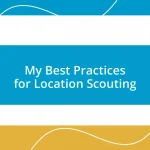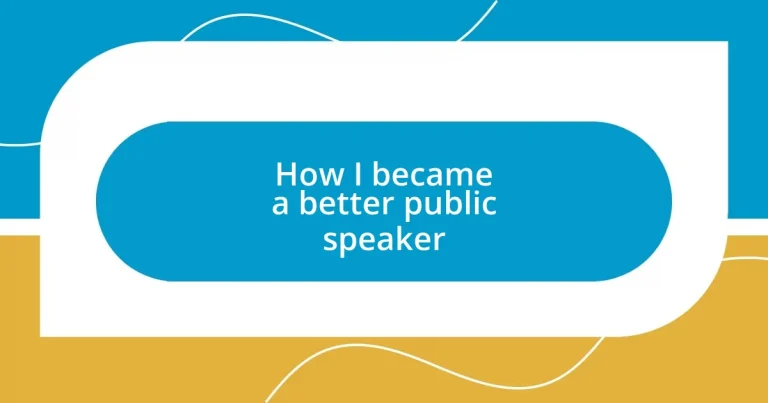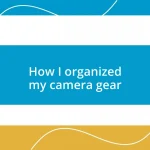Key takeaways:
- Overcoming perfectionism and embracing practice transformed the author’s public speaking journey from fear to confidence.
- Techniques such as breathing exercises, vocal modulation, and storytelling significantly enhanced speech delivery and audience engagement.
- Seeking continuous feedback and learning from both self and others improved the author’s speaking skills and adaptability.
- Authenticity and sharing personal stories created deeper connections with the audience and fostered a sense of community during presentations.
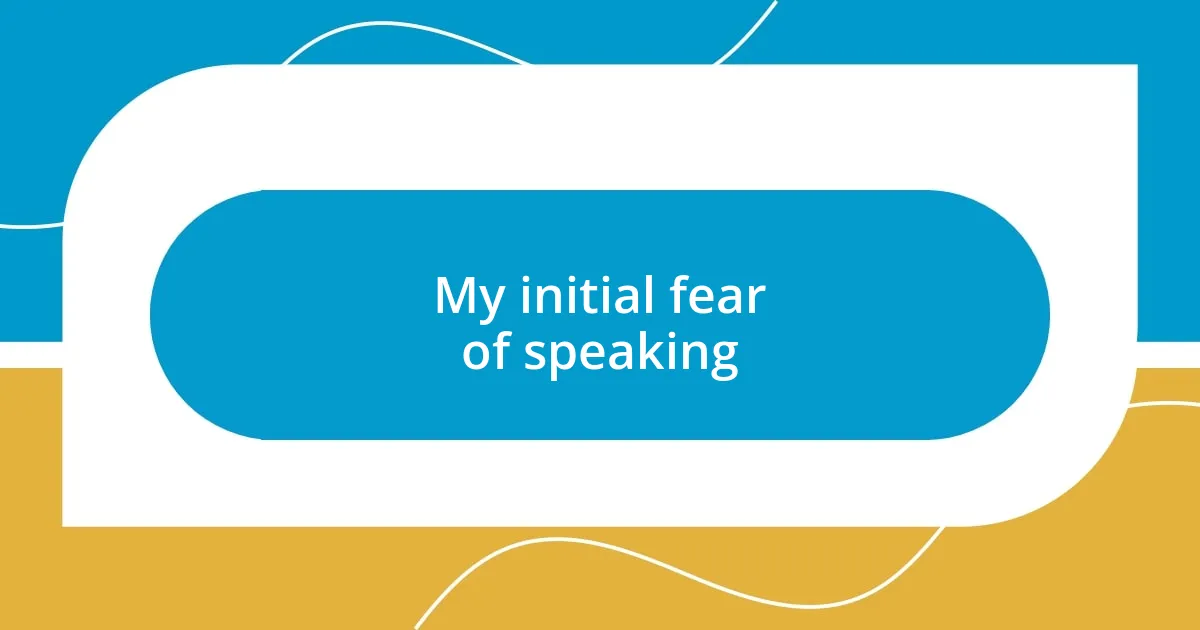
My initial fear of speaking
The first time I stood in front of an audience, my heart raced so fast I was convinced it might burst. I remember gripping the podium like it was a life raft, my palms sweating and my mind blank. Isn’t it strange how a group of people can trigger such raw vulnerability?
In those early days, I often imagined the audience judging my every word, their eyes glued to my nervous twitches. I wondered whether they even cared about what I had to say or if they were simply counting the seconds until I was done. These thoughts consumed me, making every attempt to speak feel like climbing a mountain, one I was ill-prepared to summit.
Looking back, I realize that my fear stemmed from perfectionism—I wanted to deliver flawless speeches but often ended up paralyzed by the thought of failure. Have you ever felt that pressure to be perfect? I found comfort in knowing that even seasoned speakers have faced similar battles; it’s part of the journey, right?
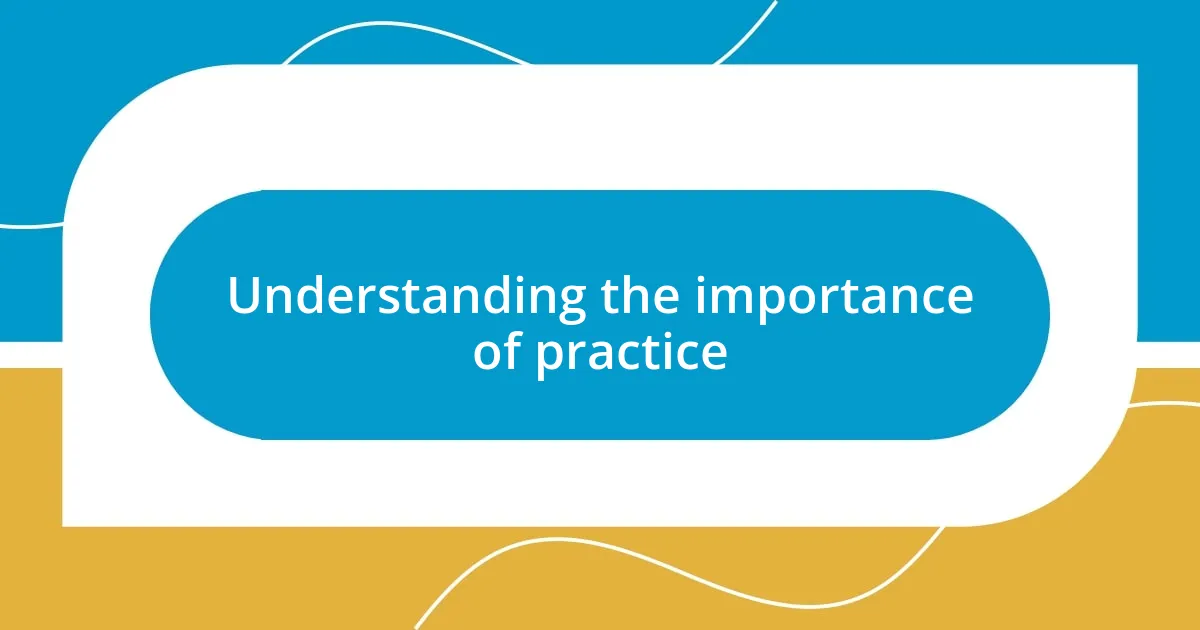
Understanding the importance of practice
To truly grasp the significance of practice, we must confront the reality that speaking publicly is a skill, much like playing an instrument. I used to think that just stepping on stage meant I could wing it, but every time I tried, I felt more like a deer caught in headlights than a confident speaker. It was only after stumbling through several presentations that I realized rehearsing was essential—not just to remember my key points, but to foster a sense of ownership over the content.
Here are a few reasons why practice became a game-changer for me:
- Familiarity: The more I practiced, the more comfortable I became with my material. It’s like taking the training wheels off a bike; after a while, you just ride.
- Confidence Boost: Each round of practice helped to build my confidence. I started to feel like I was prepared to face whatever came my way during a presentation.
- Body Language: Practice allowed me to identify gestures and expressions that felt natural. I learned how to control my nervous energy by channeling it into purposeful movements instead of awkward fidgeting.
- Feedback Learning: By rehearsing in front of friends, I collected valuable feedback. They would point out areas for improvement, which made me more aware of how I was coming across to an audience.
- Anticipating Challenges: The more I practiced, the better I became at anticipating potential pitfalls, whether it was difficult questions or technical issues. This preparedness made me feel invincible.
Ultimately, embracing a consistent practice routine transformed my experience from dread to anticipation, shifting my focus toward mastery rather than perfection. The journey wasn’t always easy, but the growth I achieved made every moment of practice worthwhile.
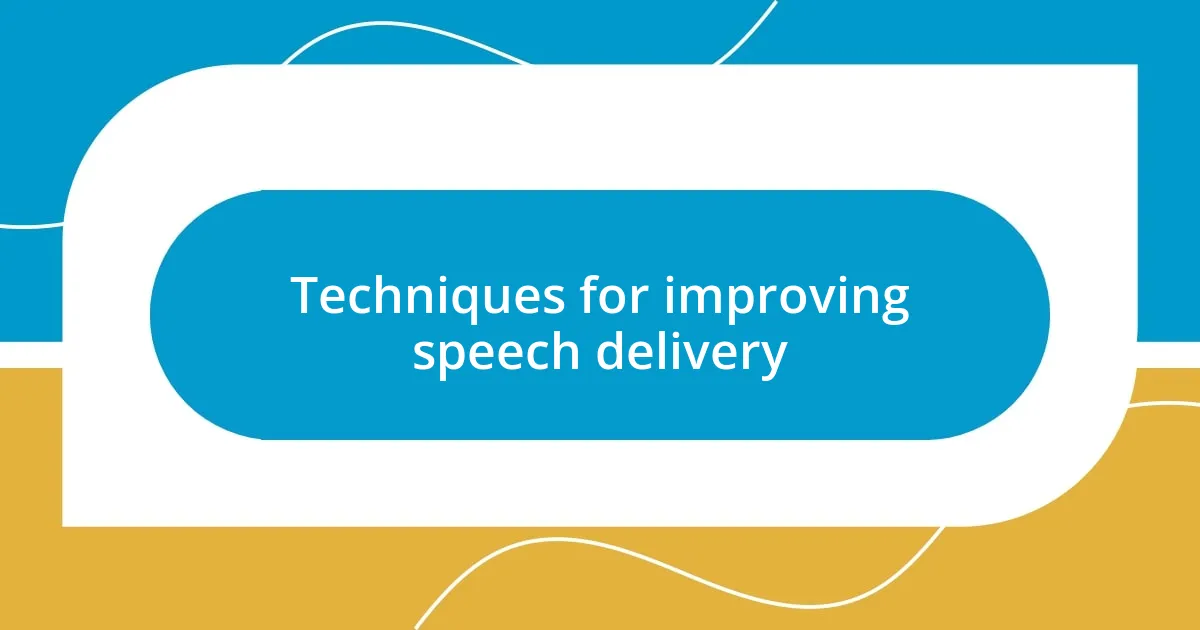
Techniques for improving speech delivery
When it comes to improving speech delivery, I can’t stress enough the importance of breathing techniques. Early on, I discovered that taking deep breaths before speaking calmed my nerves significantly. It’s fascinating how something as simple as breathing can ground you and help articulate thoughts more clearly. Have you ever noticed how your breath changes when you’re nervous? This awareness can be a powerful tool, allowing you to regain control in those tense moments.
Another technique that boosted my delivery was varied vocal modulation. Initially, I had a monotone speech that made my presentation feel flat. By consciously altering my pitch and pacing, I kept my audience engaged. I practiced using inflection to emphasize key points. It felt invigorating to see people lean in with interest when I animated my words. Have you noticed how a little change in tone can make a huge difference in how your message is received?
Lastly, I embraced the art of storytelling to enhance my speeches. I vividly remember sharing a personal anecdote that tied into my message, and watching as the audience’s eyes lit up with curiosity. They were no longer passive listeners; they were invested in my journey. This technique transformed my way of connecting with the audience, making my speeches feel more relatable and memorable. Isn’t it amazing how a simple story can break down barriers and foster connection?
| Technique | Benefit |
|---|---|
| Breathing Techniques | Helps to calm nerves and articulate thoughts clearly. |
| Vocal Modulation | Engages the audience and emphasizes key points. |
| Storytelling | Creates relatability and fosters connection with the audience. |
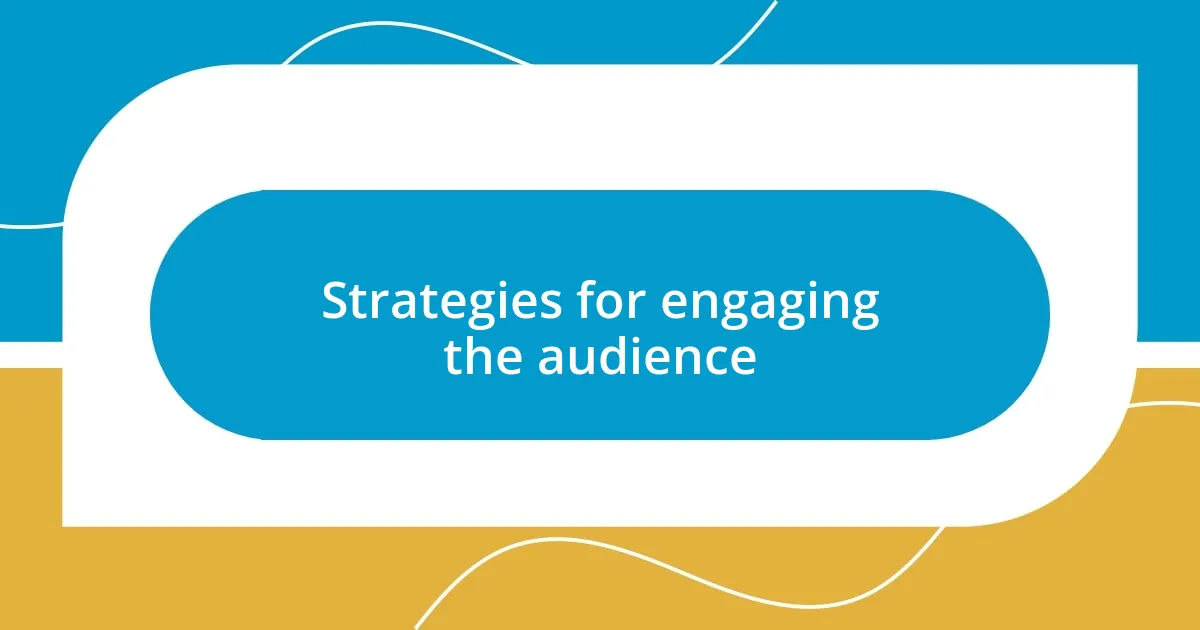
Strategies for engaging the audience
Engaging an audience goes beyond words; it’s about creating a shared experience. I learned that asking questions can be a powerful strategy. During one presentation, I posed a simple query: “How many of you have faced this challenge?” Seeing the audience nod in recognition made me feel connected. It transformed the atmosphere; suddenly, we were all in this together. Questions not only spark interest but invite your audience to participate in a dialogue rather than merely absorbing information.
Another effective strategy I implemented was the use of visuals. I once incorporated a unique image that resonated with my topic, and I could see the audience’s expressions shift from disengaged to intrigued. It’s astonishing how a strong visual can evoke emotions and enhance understanding. Have you ever noticed how an image can linger in your mind long after a presentation? It creates a lasting impression, making your message memorable.
I also discovered the impact of humor during my speeches. Early on, I was quite serious, but then I sprinkled in light-hearted moments, which created laughter and eased the tension in the room. I vividly recall cracking a joke about my early public speaking failures, and the entire audience erupted in laughter. That moment felt liberating! Humor isn’t just entertainment; it breaks down barriers and invites the audience to relax and engage openly with your message.
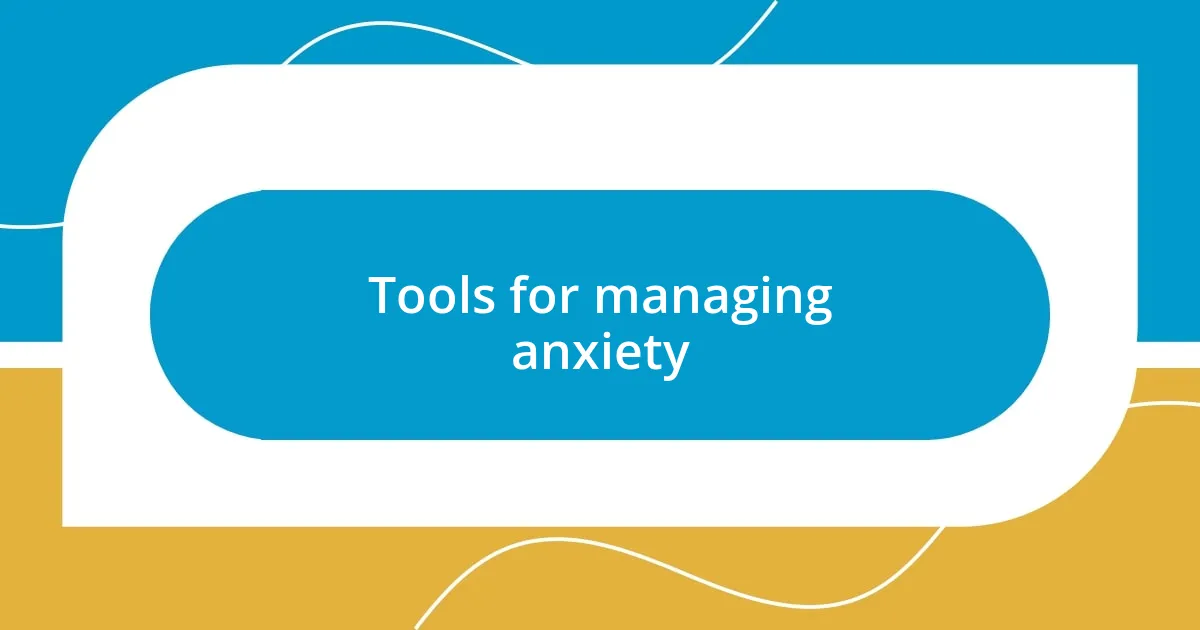
Tools for managing anxiety
Managing anxiety is crucial for effective public speaking, and I’ve found several tools that can truly help. One of my go-to strategies is visualization. Before any big speech, I take a moment to picture myself confidently addressing the audience. In my experience, this mental rehearsal not only calms my nerves but also primes me for success. Has a powerful image ever motivated you to step out of your comfort zone?
I also rely heavily on grounding techniques, particularly during moments of high anxiety. Simple methods like focusing on my feet pressing against the floor or feeling the texture of an object in my pocket really help bring me back to the present moment. One time, during a particularly nerve-wracking presentation, I noticed my palms sweating and my heart racing. By tuning into the sensation of the podium under my hands, I was able to refocus and deliver my message more clearly. Isn’t it fascinating how small physical sensations can anchor you amid chaos?
Lastly, I can’t stress enough the importance of preparation and rehearsal. I used to underestimate how much practicing a speech would benefit me until I experienced the difference it makes. A few days before, I would rehearse in front of a mirror, tweaking my delivery and catching any nervous habits. I remember one occasion when I practiced my speech with a close friend, and their positive feedback built my confidence tremendously. Does practicing out loud with someone you trust make a difference for you? I’ve found that having that support can transform anxiety into excitement.
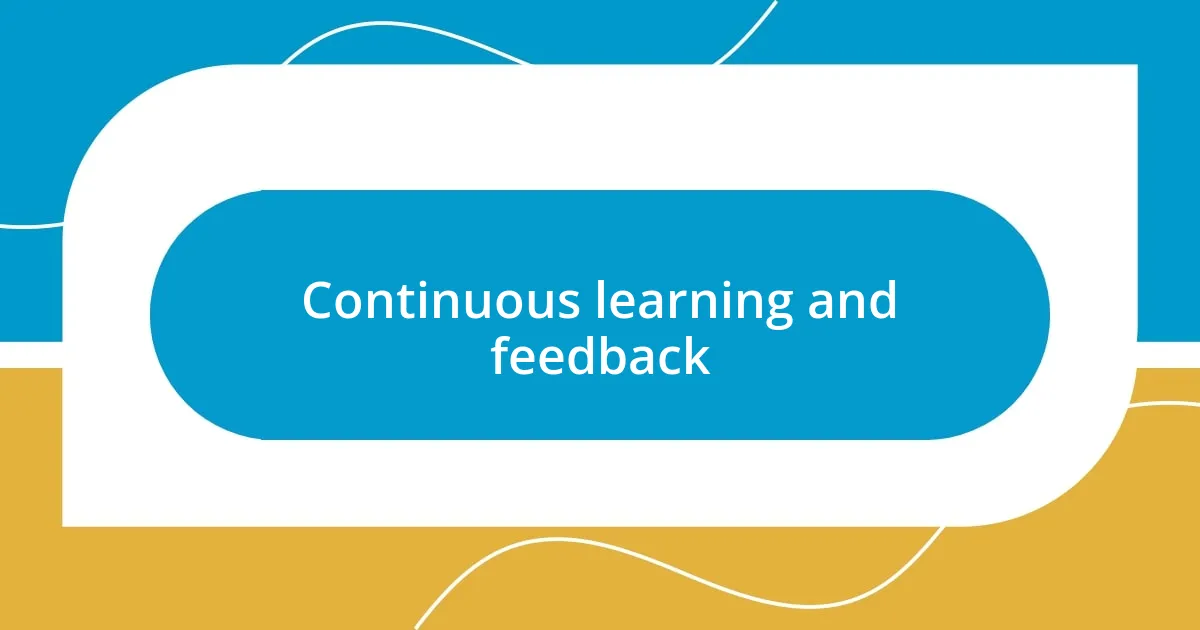
Continuous learning and feedback
Continuous learning and seeking feedback have been pivotal in my journey to becoming a better public speaker. There was a time when I thought I had mastered my delivery, but then I attended a workshop that opened my eyes. The trainer focused on receiving constructive criticism, and I remember feeling a mix of apprehension and curiosity. What if others pinpointed my flaws? It turned out that hearing honest feedback was incredibly empowering. Those moments of vulnerability became stepping stones to improvement.
After that workshop, I made it a point to seek feedback consistently. I began asking colleagues for their thoughts after each presentation, and while it felt daunting at first, the insights I gained were invaluable. I recall one instance where a colleague pointed out that my pacing was too fast during a key point. It was an eye-opener! Once I actively worked on slowing down, the response from the audience was noticeably more engaged. Isn’t it interesting how minor adjustments can make such a significant difference in how your message lands?
Through continuous learning, I also discovered the power of watching other speakers. I often find myself taking notes during TED Talks or local presentations, not just for content but for style. It’s fascinating to see how different techniques resonate with varied audiences. I’ve tried incorporating a few methods myself, like storytelling or varying vocal tones. I once watching a speaker who paused strategically, creating suspense, and I thought, “Why hadn’t I tried that before?” These experiences remind me that the journey of a speaker is never truly finished; there’s always something new to learn. Isn’t that what makes this endeavor so exciting?
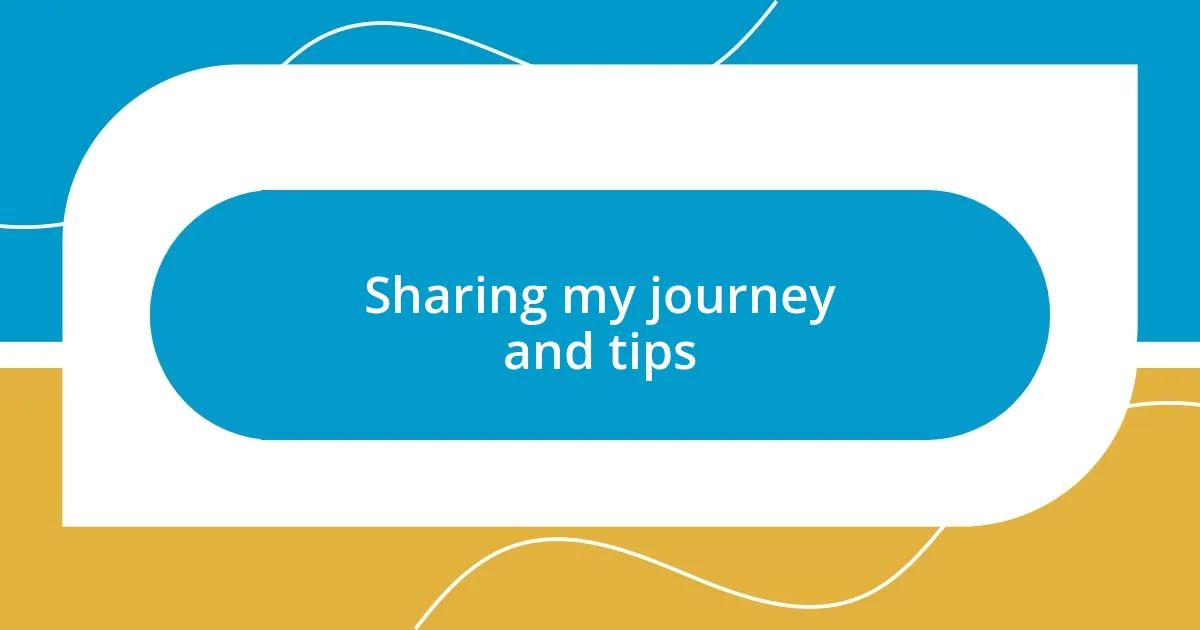
Sharing my journey and tips
Finding my voice as a public speaker has been a mix of discovery and application. I remember a time when I felt stuck, unsure how to connect with my audience. It was during a community event when I decided to share a personal story. The way I saw eyes light up and nods of understanding made me realize the impact of authenticity. Have you ever had a moment where sharing something vulnerable has changed the energy in the room? I definitely have.
As I continued this journey, I found that diversifying my speaking topics kept things fresh and engaging, not just for my audience but for me too. One particularly memorable seminar I conducted focused on overcoming challenges, and I weaved in some of my own struggles. The response was overwhelming—people approached me afterward to share their experiences, creating a sense of community. Isn’t it amazing how relatable stories can break down barriers? This taught me that drawing from our own lives not only enhances our speaking abilities but also engages the audience more deeply.
Moreover, I discovered the importance of embracing mistakes on stage. During a corporate presentation, I stumbled over a key point and felt a rush of embarrassment. Instead of glossing over it, I acknowledged the slip with humor. To my surprise, it eased the tension, and the audience felt more connected to me. Has a mishap ever turned a situation around for you? It sure did for me, teaching me that imperfections often pave the way for genuine connections. Embracing this mindset has been liberating and has undeniably shaped the speaker I am today.










